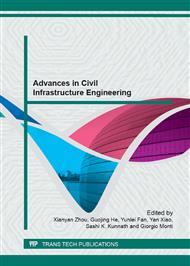p.364
p.368
p.372
p.377
p.382
p.389
p.394
p.399
p.404
Analysis of Concrete Performance Used for Non-Ballasted Track Base Plate Based on the Coupling of Effect of Acid and Carbonization
Abstract:
Combining Shi Wu Passenger Dedicated Line and considering the effect of variety and content of mineral admixtures on concrete performance, the paper has investigated the microscopic structural’s variation of C40 high performance used in non-ballasted track base plate under the coupling conditions of acid rain and carbonization by using micro-testing methods such as SEM and XRD and optimizing mix design.The effect of variation on concrete performance has also been analyzed. Results show that when the concrete was eroded in coupling conditions of acid rain and carbon corrosion, C40 high performance concrete specimens produced a certain amount of acicular and columnar ettringite, the surface structure was loose, and pore increased, in addition, plate Ca(OH)2 crystal content gradually decreased with increasing of age, the concrete strength decreased, the maximum reducing value reached to 27%, what's more, the depth of neutralization increased with age. For different erosion pattern, its influence law was: S mode<ST mode<TS mode<T mode.
Info:
Periodical:
Pages:
382-388
Citation:
Online since:
January 2013
Authors:
Price:
Сopyright:
© 2013 Trans Tech Publications Ltd. All Rights Reserved
Share:
Citation:


